When young Elizabeth Daniel Cabell died in 1830, her father, Judge William Daniel, Sr., became heir to Point of Honor. Judge Daniel was well known in Lynchburg and the surrounding country because he was the judge for the Campbell and Cumberland Circuits. William Daniel, Sr., sometimes referred to as "the elder," served in the Virginia General Assembly in 1798-1799 before being appointed to the bench in 1807. His first wife was Margaret Baldwin of Winchester, the daughter of Dr. Cornelius Baldwin.
The death of Eliza in 1830 left Judge Daniel the owner of Point of Honor. He moved in by 1831 and extensively redecorated the house according to a letter written that year by his daughter Mary Cornelia. Fashion had changed in the fifteen years since the house was completed and extensive paint analysis done in 1976 revealed that almost all of the brilliantly colored mantels and carvings were painted black which would be more in keeping with the contemporary Greek Revival mode.
In 1837 Judge Daniel’s daughter Elvira married Charles Ellet, Jr., then the chief engineer for the James River and Kanawha Canal Company. The wedding took place at Point of Honor in late October or early November 1837. Ellet is recognized as one of America's pioneer civil engineers, and died a hero commanding a flotilla of Union gunboats during the Civil War. Their daughter, Mary Virginia Ellet, married William D. Cabell of Norwood, Virginia, and was one of the founders of the national Daughters of the American Revolution organization. Other than redecorating, little is known of the changes made to Point of Honor during the life of William Daniel, Sr.
William Daniel, Jr., was a lawyer like his father, and like his father, was a member of the Virginia legislature and served as Judge of the Supreme Court of Appeals from 1846 to 1865. In December 1841, he married Sarah Ann Warwick, the mother of John Warwick Daniel, Lynchburg's famous "Lame Lion." Preparations apparently were being made for a new mistress at Point of Honor as early as August of that year when William, Jr., wrote to his sister Elvira Daniel Ellet in Philadelphia with instructions to purchase various furnishings for him for the parlor and (bed) chamber. Among the items requested were a sideboard, sofa, tables, chairs, mirrors, bedstead and draperies, rocking chairs, and astral lamps. In subsequent letters in September and October, Daniel reported that he had the house papered and painted and the exterior covered with stucco.

